Oral Session
All About Psychiatry with MRI
ISMRM & ISMRT Annual Meeting & Exhibition • 03-08 June 2023 • Toronto, ON, Canada

| 15:45 |
0639.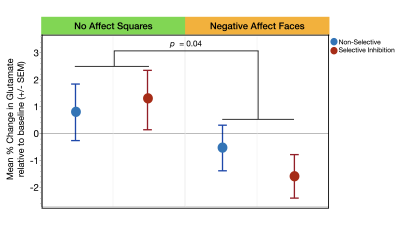 |
Distinct dACC Glutamate Modulation during Inhibitory Motor
Control Driven by Negative Emotional Stimuli in Trauma-Exposed
Youth using 1H fMRS
John McClellan France1,
Dalal Khatib1,
Sharuel A. Valbrun1,
William M. Davie1,
Jillian Eichstaedt1,
Vaibhav A. Diwadkar1,
Tanja Jovanovic1,
and Jeffrey Stanley1
1Wayne State University, Detroit, MI, United States Keywords: Psychiatric Disorders, Trauma, Adolescent Development We investigated changes in glutamate in the dACC in children exposed to childhood trauma during motor control function with and without inhibition as well as with and without stimuli depicting negative affect using 1H fMRS. Independent of motor control with/without inhibition, trauma-exposed children exhibited a significant reduction in dACC glutamate when stimuli of negative affect were present, relative to stimuli without affect. These results provide greater insight on the neurochemistry supporting the influence of negative emotional context on motor control and highlight potential novel biomarkers for risk and resilience to posttraumatic stress. |
| 15:53 |
0640.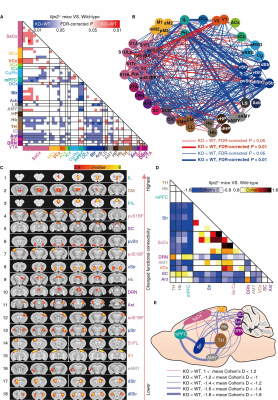 |
Astrocyte dysfunction drives abnormal resting-state functional
connectivity in depression
Jiaming Liu1,
Jia-Wen Mo2,
Xunda Wang3,4,
Ziqi An1,
Shuangyang Zhang1,
Can-Yuan Zhang2,
Peiwei Yi1,
Alex T. L. Leong3,4,
Jing Ren2,
Liang-Yu Chen2,
Ran Mo2,
Yuanyao Xie1,
Qianjin Feng1,
Wufan Chen1,
Tian-Ming Gao2,
Ed X. Wu3,4,
Yanqiu Feng1,2,5,6,
and Xiong Cao2,7
1School of Biomedical Engineering, Southern Medical University, Guangzhou, China, Guangzhou, China, 2Key Laboratory of Mental Health of the Ministry of Education, Guangdong-Hong Kong-Macao Greater Bay Area Center for Brain Science and Brain-Inspired Intelligence, Guangdong Province Key Laboratory of Psychiatric Disorders, Department of Neurobiology, School of Basic Medical Sciences, Southern Medical University, Guangzhou 510515, China, Guangzhou, China, 3Laboratory of Biomedical Imaging and Signal Processing, The University of Hong Kong, Pokfulam, Hong Kong SAR, China, Hong Kong, China, 4Department of Electrical and Electronic Engineering, The University of Hong Kong, Pokfulam, Hong Kong SAR, China, Hong Kong, China, 5Guangdong Provincial Key Laboratory of Medical Image Processing, Southern Medical University, Guangzhou, China, Guangzhou, China, 6Guangdong Province Engineering Laboratory for Medical Imaging and Diagnostic Technology, Southern Medical University, Guangzhou, China, Guangzhou, China, 7Microbiome Medicine Center, Department of Laboratory Medicine, Zhujiang Hospital, Southern Medical University, Guangzhou, Guangdong 510515, China, Guangzhou, China Keywords: Brain Connectivity, fMRI Even though brain-wide network-level abnormalities in major depressive disorder (MDD) patients via resting-state functional MRI (rsfMRI) exist, the mechanisms underlying such network changes are unknown. Here, we show that the astrocytic calcium deficient mice, inositol 1,4,5-trisphosphate-type-2 receptor knockout mice (Itpr2-/- mice), display abnormal rsfMRI connectivity (rsFC), which is highly consistent with those of MDD patients. Optogenetic activation of medial prefrontal cortex (mPFC) astrocytes partially rescues rsFC. Optogenetic activation of the mPFC neurons or mPFC-striatum pathway rescues disrupted rsFC and depressive-like behaviors in Itpr2-/- mice. Our results identify the previously unknown role of astrocyte dysfunction in driving rsFC abnormalities in depression. |
| 16:01 |
0641.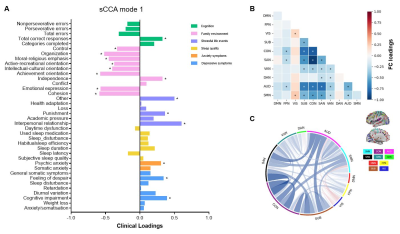 |
Multivariate association between brain functional networks and
symptoms and psychosocial environment in adolescent depression
Yingxue Gao1,
Ruohan Feng2,
Yang Li3,
Zilin Zhou1,
Kaili Liang1,
Weijie Bao1,
Lihua Zhuo2,
Guoping Huang3,
and Xiaoqi Huang1,4 1Huaxi MR Research Center (HMRRC), Functional and Molecular Imaging Key Laboratory of Sichuan Province, Department of Radiology, West China Hospital of Sichuan University, Chengdu, China, 2Department of Radiology, Sichuan Mental Health Center, the Third Hospital of Mianyang, Mianyang, China, 3Department of Psychiatry, Sichuan Mental Health Center, the Third Hospital of Mianyang, Mianyang, China, 4Psychoradiology Research Unit of the Chinese Academy of Medical Science , West China Hospital of Sichuan University, Chengdu, China Keywords: Psychiatric Disorders, fMRI (resting state), Depression The current study investigated the multivariate correlations between resting-state functional network connectivity and symptoms and environmental measures in adolescents with major depressive disorder (MDD) using the sparse canonical correlation analysis. We identified one stable association mode which showed primary correlation of environmental stressors, especially the interpersonal stress, with functional connectivity of networks that support salience processing, reward and sensory processing. Based on this brain-behavior association, we were able to categorize adolescents with MDD into two subgroups and delineate how psychosocial factors contributed to the neurobiological mechanism underlying adolescent depression. |
| 16:09 |
0642.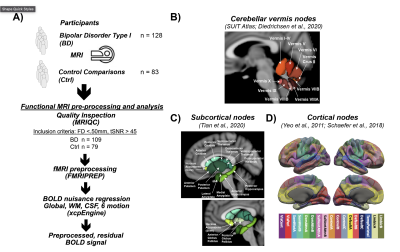 |
Functional Connectivity of the Cerebellar Vermis in Bipolar
Disorder
Vincent Magnotta1,
Arshaq Saleem2,
Gail Harmata1,
Shivangi Jain2,
Michelle W Voss3,
Jess G Fiedorowicz4,
Aislinn Williams3,
Joseph J Shaffer5,
Jenny Gringer Richards3,
Ercole John Barsotti3,
Leela Sathyaputri3,
Samantha L Schmitz6,
Gary E Christensen3,
Jeffrey D Long3,
Jia Xu3,
and John A Wemmie3
1Radiology, University of Iowa, Iowa City, IA, United States, 2Psychological and Brain Sciences, University of Iowa, Iowa City, IA, United States, 3University of Iowa, Iowa City, IA, United States, 4University of Ottawa, Ottawa, ON, Canada, 5University of Kansas City, Kansas City, MO, United States, 6Des Moines University, Des Moines, IA, United States Keywords: Psychiatric Disorders, fMRI (resting state) This study used resting state functional connectivity to study connectivity of the cerebellar vermis with the cerebrum in bipolar disorder. |
| 16:17 |
0643.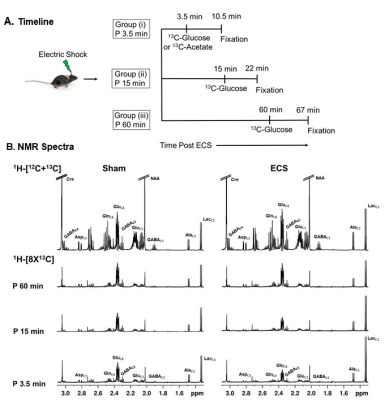 |
Uncoupling of Anaerobic Glucose Metabolism and Oxidative
Phosphorylation following Acute Electroconvulsive Shock in Mice
Brain
Ajay Sarawagi1,2 and
Anant Bahadur Patel1,2
1Department of NMR Microimaging and Spectroscopy, CSIR - Center for Cellular and Molecular Biology, Hyderabd, India, 2Academy of Scientific & Innovative Research (AcSIR), Ghaziabad, India Keywords: Psychiatric Disorders, Spectroscopy, Metabolism, Glutamate, GABA, 13C NMR Electroconvulsive therapy (ECT) is an established treatment for drug-resistant depression. However, the impact of ECT on neurotransmitter pathways is not clear. The cerebral metabolic rates were measured post ECS in mice using 1H-[13C]-NMR spectroscopy in conjunction with intravenous [1,6-13C2]glucose infusion. The concentrations of lactate, alanine, GABA, and choline were increased in the prefrontal cortex post 3.5 min of ECS. The concentrations of alanine-C3 and lactate-C3 increased after 3.5 min of ECS. In contrast, glutamatergic and GABAergic neurometabolic activity was reduced 3.5 min post ECT, and restored in an hour. These data indicate the dominance of glycolysis in the post-ictal period. |
| 16:25 |
0644.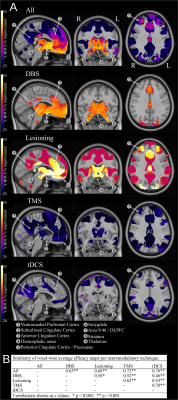 |
A common brain network underlying successful neuromodulatory
treatment of Obsessive-Compulsive Disorder
Jurgen Germann1,
Gavin JB Elias1,
Emily HY Wong1,
Kazuaki Yamamoto2,
Artur Vetkas1,
Flavia V Gouveia3,
Aaron Loh1,
Alexandre Boutet1,
and Andres M Lozano1
1University Health Network, Toronto, ON, Canada, 2Functional Neurosurgery Center, Shonan Fujisawa Tokushukai Hospital, Fujisawa, Japan, 3Neuroscience and Mental Health, Hospital for Sick Children Research Institute, Toronto, ON, Canada Keywords: Psychiatric Disorders, Psychiatric Disorders, Obsessive-compulsive disorder Obsessive-compulsive disorder (OCD) is a debilitating condition, with up to 20% of patients being refractory to medical treatment. For these severe cases, neuromodulatory techniques targeting distinct brain areas have been successful. In this work, we used normative functional connectomics to identify the brain network underlying symptom improvement in OCD. A pan-modality efficacy map identified cortical and subcortical areas as key regions, and this specific network could be used to successfully predict clinical improvement. These results suggest that symptom reduction following neuromodulation involves the engagement of a common functional network that could be investigated as a biomarker of treatment success. |
| 16:33 |
0645.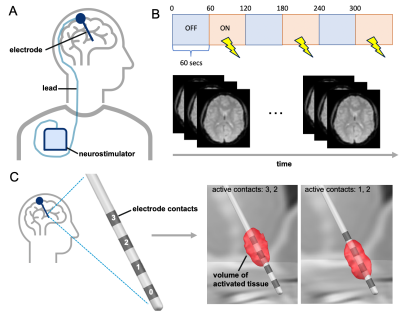 |
ACC Connectivity Changes during ALIC Deep Brain Stimulation for
Obsessive Compulsive Disorder
Sushil Bohara1,
Natalya Slepneva2,
Tenzin Norbu2,
Moses Lee2,
and Melanie A. Morrison3 1University of California, Berkeley, Berkeley, CA, United States, 2Department of Psychiatry & Behavioral Sciences, University of California, San Fransciso, San Francisco, CA, United States, 3Radiology & Biomedical Imaging, University of California, San Fransciso, San Francisco, CA, United States Keywords: Brain Connectivity, Psychiatric Disorders Chronic deep brain stimulation (DBS) of the anterior limb of the internal capsule (ALIC) is an emergent therapy for severe cases of obsessive-compulsive disorder (OCD), however patient response is variable with only 50-60% of patients classified as responders. Toward optimizing therapy for the individual patient and improving overall treatment efficacy, here we used fMRI during ALIC stimulation to evaluate changes in OCD network functional connectivity. In 5 patients, we found that DBS, when in a therapeutic configuration for the patient, may be reducing abnormal hyperconnectivity to improve symptoms, while nontherapeutic configurations may be disrupting fronto-posterior connections causing unwanted symptoms. |
16:41 |
0646.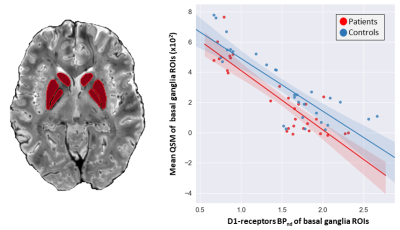 |
7T MRI and PET in Tourette Syndrome: Correlations between
subcortical dopamine receptor availability and susceptibility
Dimitrios G. Gkotsoulias1,
Michael Rullmann2,
Simon Schmitt3,
Anna Bujanow1,
Franziska Zientek2,
Konstantin Messerschmidt2,
Kirsten Müller-Vahl3,
Henryk Barthel2,
and Harald E. Möller4
1NMR Group, Max Planck Institute for Human Cognitive and Brain Sciences, Leipzig, Germany, 2Department of Nuclear Medicine, University of Leipzig, Leipzig, Germany, 3Clinic of Psychiatry, Social Psychiatry and Psychotherapy, Hannover Medical School, Hannover, Germany, 4Max Planck Institute for Human Cognitive and Brain Sciences, Leipzig, Germany Keywords: Psychiatric Disorders, PET/MR, QSM, 7T, Tourette Syndrome, PET, Dopamine, Receptors, D1 We present interim results of the first combined 7T MRI and [11C]-SCH23390 PET study in Gilles de la Tourette syndrome (GTS). Dopamine D1-receptor availability is assessed in combination with Quantitative Susceptibility Mapping (QSM). Our results indicate reduced iron concentrations in subcortical grey matter of GTS patients compared to age- and sex-matched controls, accompanied by reduced D1-receptor binding potential in several regions. Correlations between local iron distribution and D1-receptor binding potential in basal ganglia support the hypothesis that iron homeostasis might play a significant role in dysregulations of the dopaminergic system that eventually lead to the characteristic symptomatology of GTS. |
| 16:49 |
0647.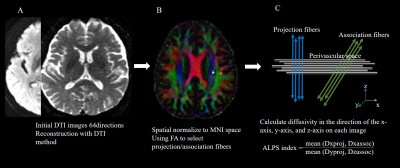 |
Glymphatic system dysfunction in Primary Insomnia evidenced by
diffusion tensor imaging with the perivascular space (DTI-ALPS)
Yu Jin1,
Xiaoyong Zhang2,
Xin Ding3,
and Guangwen Chen1 1Department of Radiology, Chengdu Second Peolpe's Hospital, Chengdu, China, 2Clinical Science, Philips Healthcare, Chengdu, China, 3Department of Neurology, Chengdu Second Peolpe's Hospital, Chengdu, China Keywords: Psychiatric Disorders, Microstructure Sleep has been hypothesized to assist waste clearance from the brain. We aimed to determine whether primary insomnia is associated with glymphatic system dysfunction by using diffusion tensor imaging (DTI) with the perivascular space (DTI-ALPS), a potential marker of impaired brain waste clearance. In this study, we found that the DTI-ALPS in patients with primary insomnia was significantly lower than in healthy controls and the DTI-ALPS index was significantly negatively correlated with neuropsychological performance score. The results suggests that DTI-ALPS may be a useful imaging tool for studying glymphatic system function with primary insomnia. |
| 16:57 |
0648.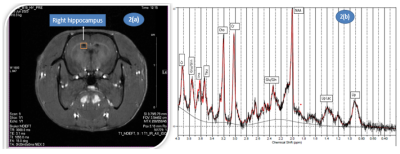 |
Metabolic changes in hippocampus in preclinical model due to
chronic noise exposure: An in-vivo 1H Magnetic Resonance
Spectroscopy study.
Nisha Chauhan1,
S Senthil Kumaran1,
and Himanshu Singh1
1Department of Nuclear Magnetic Resonance, All India Institute of Medical Sciences, New Delhi, India Keywords: Psychiatric Disorders, Brain, Stress, Depression, Pre clinical, MRS Occupational and environmental noise contributes to major public health issues. The chronic high level noise exposure may cause stress and depression and also alterations in Neurometabolites. In-vivo 1H MRS and Open-Field Test are carried out to elucidate the changes in brain metabolite and its effect on behavior due to chronic noise exposure in a preclinical model. A significant increase in Glutamate and N- Acetylaspartate metabolite was observed in hippocampus which is an important target to study the effects of stress. Reduced total movement time, movement distance and mean velocity were observed in the noise exposed group. |
| 17:05 |
0649.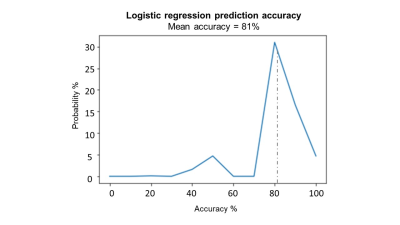 |
Quantitative MRI biomarkers of pathology in a Poly I:C rat
lactational model of schizophrenia and depression
Coral Helft1,
Tamar Katzir2,
Noam Omer2,
Emilya Natali Shamir3,
Yeal Piontkewitz3,
Ina Weiner3,
Shimon Shahar 4,
and Noam Ben-Eliezer1,2,5 1Sagol School of Neuroscience, Tel Aviv University, Tel Aviv, Israel, 2Department of Biomedical Engineering, Tel Aviv University, Tel Aviv, Israel, 3School of Psychological Sciences, Tel Aviv University, Tel Aviv, Israel, 4Center of AI and Data Science (TAD), Tel Aviv University, Tel Aviv, Israel, 5Center for Advanced Imaging Innovation and Research (CAI2R), New-York University Langone Medical Center, New York, NY, United States Keywords: Psychiatric Disorders, Quantitative Imaging, Psychiatric disorders, Neuroscience, Multi-Contrast Many psychiatric conditions lack radiologic markers of disease. In this study, we investigated the utility of quantitative MRI (qMRI) for detecting pathology in the lactational immune activation rat model of schizophrenia and depression. Results show that a logistic regression model can identify the disease with an accuracy of 81% based on a combination of T1 and T2, mean diffusivity, and fractional anisotropy values. This finding suggests that multiparametric qMRI is useful for monitoring pathology with an objective quantitative tool that goes beyond structural deformations and improves the sensitivity to microstructural and neurochemical pathology in the lactational immune activation rat model. |
| 17:13 |
0650.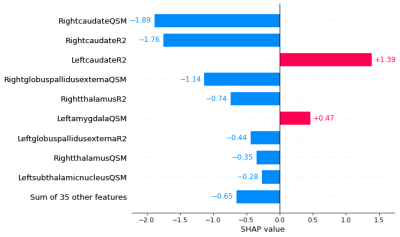 |
Identification of Quantitative Susceptibility Biomarkers for
First Episode Psychosis using XGBoost
Pamela Franco1,2,
Cristian Montalba1,2,3,
Raul Caulier-Cisterna1,2,
Marisleydis García1,2,4,
Alonso González5,6,
Juan Undurraga5,7,
Nicolás Crossley2,5,
Cristian Tejos1,2,4,
and Sergio Uribe1,2,3
1Biomedical Imaging Center, Pontificia Universidad Catolica de Chile, Santiago, Chile, 2Millennium Institute for Intelligent Healthcare Engineering - iHEALTH, Pontificia Universidad Catolica de Chile, Santiago, Chile, 3Radiology Department, School of Medicine, Pontificia Universidad Catolica de Chile, Santiago, Chile, 4Electrical Engineering Department, School of Engineering, Pontificia Universidad Catolica de Chile, Santiago, Chile, 5Department of Psychiatry, School of Medicine, Pontificia Universidad Catolica de Chile, Santiago, Chile, 6School of Medicine, Universidad Finis Terrae, Santiago, Chile, 7Pharmacovigilance, Instituto Psiquiátrico Dr J. Horwitz Barak, Santiago, Chile Keywords: Psychiatric Disorders, Quantitative Susceptibility mapping Several studies have demonstrated altered neurochemicals in deep-brain nuclei of psychosis patients. These alterations suggest a dopamine dysfunction in subcortical areas. QSM images quantify magnetic susceptibility changes in the brain. These changes are usually associated with iron concentrations and co-factor in dopamine pathways of the neurons. We propose a method based on machine learning to discriminate between psychosis patients and healthy controls by looking at the magnetic susceptibility of 9 deep gray matter nuclei, obtaining a precision of 91.6%. |
| 17:21 |
0651.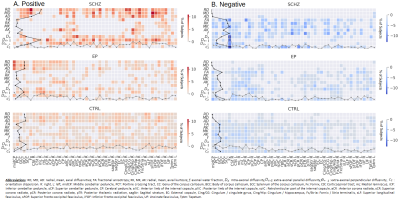 |
Normative Modelling of White Matter Microstructure in Early
Psychosis and Schizophrenia
Tommaso Pavan1,2,
Yasser Alemán-Gómez1,2,
Raoul Jenni2,3,
Martine Cleusix2,3,
Luis Alameda2,4,
Kim Quang Do Cuenod2,3,
Philippe Conus2,4,
Paul Klauser2,5,
Patric Hagmann1,2,
and Ileana Jelescu1,2
1Department of Radiology, Lausanne University Hospital (CHUV), Lausanne, Switzerland, 2University of Lausanne (UNIL), Lausanne, Switzerland, 3Center for Psychiatric Neuroscience, Department of Psychiatry, Lausanne University Hospital (CHUV), Lausanne, Switzerland, 4General Psychiatry Service, Treatment and Early Intervention in Psychosis Program (TIPP-Lausanne), Lausanne University Hospital (CHUV), Lausanne, Switzerland, 5Center for Psychiatric Neuroscience and Service of Child and Adolescent Psychiatry, Department of Psychiatry, Lausanne University Hospital (CHUV), Lausanne, Switzerland Keywords: Psychiatric Disorders, Microstructure, Schizophrenia, Neuroinflammation, Neurodegeneration, Microstructure, Diffusion, White Matter The great majority of studies in schizophrenia (SCHZ) failed to achieve recognizable spatial patterns of the disease due to its heterogeneity. With this abstract, the authors aim to understand WM microstructure patterns from an individual perspective in early psychosis and SCHZ using advanced diffusion MRI metrics, namely diffusion kurtosis imaging (DKI), the WM microstructure model White Matter Tract Integrity – Watson (WMTI-W) and normative modelling, a statistical method for studying individual differences as extreme deviations from the normality. Overall, deviations in SCHZ subjects were twice as frequent when compared to EP or CTRL while EP displayed more spatial heterogeneity. |
| 17:29 |
0652.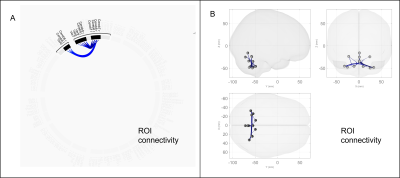 |
Prominent role of cerebellar communication in schizophrenia
reflected by resting state fMRI connectivity
Shukti Ramkiran1,2,
Ravichandran Rajkumar1,2,
Claudia Régio Brambilla1,
Linda Orth2,
Hasan Sbaihat1,
Nicolas Kaulen1,
Jörg Mauler1,
Tanja Veselinović1,2,
Nibal Khudeish1,
Lutz Tellmann1,
Karl-Josef Langen1,3,4,
Christoph Lerche1,
N. Jon Shah1,3,4,5,
and Irene Neuner1,2 1Institute of Neuroscience and Medicine - 4 (INM- 4), Forschungszentrum Jülich, Juelich, Germany, 2Department of Psychiatry, Psychotherapy and Psychosomatics, Uniklinik RWTH Aachen, Aachen, Germany, 3Department of Nuclear Medicine, Uniklinik RWTH Aachen, Aachen, Germany, 4Department of Neurology, Uniklinik RWTH Aachen, Aachen, Germany, 5Institute of Neuroscience and Medicine 11 (INM - 11), Forschungszentrum Jülich, Juelich, Germany Keywords: Psychiatric Disorders, fMRI (resting state), Schizophrenia Schizophrenia is a complex neuropsychiatric disorder, the pathophysiology of which is unclear. Several studies have shown the involvement of altered brain communication. Several new voxel-level connectivity measures such as radial similarity, radial correlation, inter-hemispheric connectivity and local correlation have enabled a deeper understanding of alterations in communication. Our results reveal the prominent role of the cerebellum in schizophrenia by investigating voxel-level connectivity in resting state fMRI data. |
| 17:37 |
0653.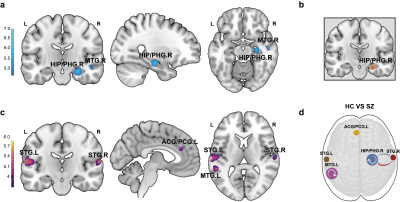 |
Disrupted Associations between the Transcriptome Profile, Brain
Structure and Function, and Cognitive Ability in Schizophrenia
Shu-wan Zhao1,
Hong Yin2,
and Long-biao Cui1 1Fourth Military Medical University, Xi'an, China, 2Xi’an People’s Hospital (Xi’an Hourth Hospital), Xi'an, China Keywords: Psychiatric Disorders, Genetics, Schizophrenia Cognitive dysfunction is considered to be one of the core symptom dimensions of schizophrenia. To deconstruct the underlying etiological behind cognitive deficits from a more integrated and multidimensional perspective, we established a trans-scale dataset at the level of the individual corresponding to each participant and control, containing blood-sample transcriptome profile, neuroimaging endophenotypes, and cognitive ability. Multivariate correlation analysis and mediation analysis demonstrated that the gene-brain-cognition association2Xi’an People’s Hospital (Xi’an Hourth Hospital), Xi'an, China Keywords: Psychiatric Disorders, Genetics, Schizophrenia Cognitive dysfunction is considered to be one of the core symptom dimensions of schizophrenia. To deconstruct the underlying etiological behind cognitive deficits from a more integrated and multidimensional perspective, we established a trans-scale dataset at the level of the individual corresponding to each participant and control, containing blood-sample transcriptome |